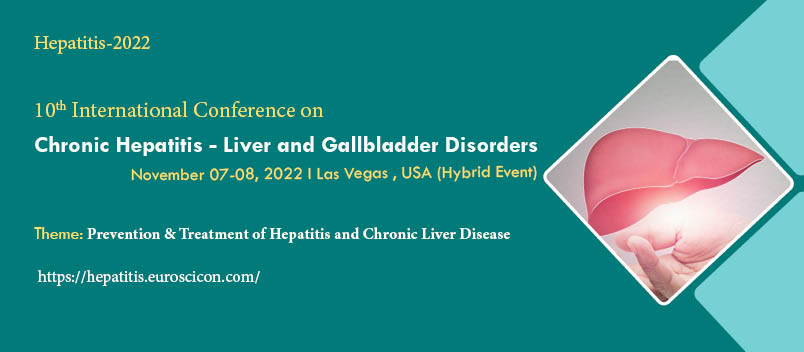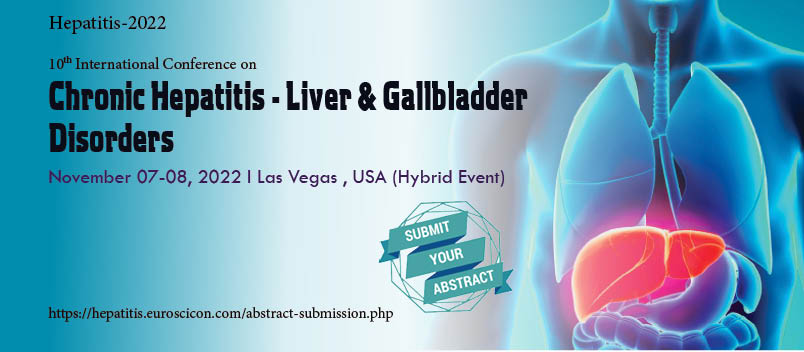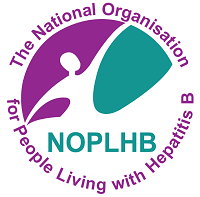hepatitis 2022
ABOUT CONFERENCE
We are honoured to invite you to the 7th International Conference on Hepatitis and Liver Diseases (Hepatitis 2022) is going on Las Vegas, US during November 07-08, 2022. The conference highlights the theme “Raising awareness and advancement towards Hepatitis and Liver Diseases”.
The conference invites Hepatologists, Gastroenterologists, Virologists, Microbiologists, immunologist, Pathologists, Oncologists, Researchers, Students, Young researchers and business delegates across the World.
Hepatitis 2022 Conference is to bring top experts together and delegates for an in-depth discussion on Hepatitis and Liver diseases. To create awareness for both rural and urban population about liver disease it should be diagnosed at early stages. The importance of this conference is to update, clinically relevant audience regarding the evidence supporting current clinical practices in hepatitis. The information presented is intended to enhance clinical competence in the diagnosis and treatment of hepatitis and liver disease.
Conference Highlights
- Hepatitis B
- Hepatitis C
- Hepatitis A, D & E
- Hepatitis Vaccination
- Hepatitis Clinical Research Trials
- Non-viral Hepatitis
- Epidemiology of Hepatitis
- Hepatocellular Carcinoma
- Liver Diseases
- Metabolic Liver diseases
- Hepato-Biliary Disease
- Liver diseases
- Liver Transplantation and Surgery
- Gastroenterology
- HCV/HIV Coinfection
- Hepatitis Diagnosis and Treatment
- Biliary Astresia
- Hepatotoxicity
- Hepatic Encephalopathy
- Gene expression in Hepatitis
- Clinical Trials
SESSIONS AND TRACKS
SESSIONS AND TRACKS
Track 1: Hepatitis B
Hepatitis B is an infectious disease which causes inflammation in the liver. Hepatitis B is caused by Hepatitis virus (HBV). For some of the people, Hepatitis B became chronic; it means the symptoms last more than 6 months. Due to long lasting symptoms of this virus it may causes risk to the liver and causes certain disease like liver damage i.e. liver cancer or liver cirrhosis which causes permanent scar of the liver. Most of the adult those who are suffering from Hepatitis B virus get cured even they have sign and symptoms in severe. But infant and children those who are suffering from HBV have more likely to develop a Chronic Hepatitis B infection. HBV can survive outside at least for 7days still the virus have the ability to cause the infection. A vaccine can prevent from hepatitis infection.
But there is no such cure for the person those who already in the condition. If you are infected then you can only prevent by taking certain precautions for the spreading the virus to the others.
Pathogenesis and clinical manifestation of Hepatitis B is due to interaction of HBV and host immune system, which leads to liver damage, liver cancer or liver cirrhosis and hepatocellular carcinoma.
Track 2: Hepatitis A, D&E
Now a day’s hepatitis A is a commonly causing viral disease which causes inflammation in the liver. It is caused by hepatitis A virus. It is a short term disease that will not develop to the chronic disorder. This virus is transmitted from one person to another through faecal-oral infection (food or drinks that has been contaminated with stool of a person who already affected by this virus) . HAV commonly spread in those areas where poor sanitary conditions or where good personal cleanliness is not observed well.
It is additionally referred to as delta virus. HDV (Hepatitis D virus) is an RNA virus it needs hepatitis B virus to replicate. HDV causes illness only in those patients who have the hepatitis B virus. Transmission happens through infected blood, needles, or sexual contact from an infected person. HDV infection can be prevented by the hepatitis B vaccine and avoiding those activities that results in attain this virus. Those that don’t seem to be vaccinated to HBV square measure in danger of obtaining this viral disease that result in cause hepatitis D.
Hepatitis E is an infectious disease which causes inflammation in the liver. It is caused by hepatitis E virus. According to resent survey 20 million cases of hepatitis E infection are been registered. And 44,000 of these cases resulted in death. It is more common in developing countries. Hepatitis E usually resolves by itself, but may develop into acute liver failure.
Track 3: Hepatitis C
Hepatitis C is the viral infectious disease which causes inflammation in the liver. It can be either acute or chronic. Hepatitis C caused by the Hepatitis C virus (HCV). HCV can be transferred by exposure to infected blood, intravenous drug abuse with the use of contaminated. Some people who experience the hepatitis C virus for short time (up to six months) and then they get better on their own. This is called acute Hepatitis C. But most of the people (around 75% – 85%) will go on to develop chronic (long-term) Hepatitis C, it means doesn’t go away. Worldwide, viral hepatitis kills more than one million people each year, and more than 350 million people are chronically infected with Hepatitis C. Hepatitis C virus doesn’t show any symptoms or very mild symptoms in the early stage. Many people don’t have an idea that they are suffering from hepatitis c virus until liver damage show up. Sometimes they get to know by routine medical testing. The recent significant advancements in treating hepatitis C build-up the improvements over the previous two decades to transform hepatitis C from a chronic, fatal disease, to an infection that with new and upcoming treatments, can be potentially cured.
Track 4: Hepatocellular carcinoma
Hepatocellular carcinoma is that the primary distortion for the foremost liver cancers. This kind of carcinoma occurs in principally in men as compare to women and typically seen in individuals age fifty and higher. It is commonly related with liver cirrhosis and hepatitis. The incidence of hepatocellular carcinoma is highest in Asia and Africa, wherever the endemic high prevalence of Hepatitis B and Hepatitis C strongly predisposes to the event of chronic disease and subsequent development of Hepatocellular carcinoma (HCC). Other risk factors can include a history of alcohol abuse. Hepatocellular carcinoma is that the third leading reason for cancer deaths worldwide, with manifested 16–32 times higher in developing countries than in developed countries. Several studies have incontestable that 10%-25% of HCC develops in those person who already suffered with chronic Hepatitis B. Hepatitis B carriers have the life time risk of getting Hepatocellular carcinoma sickness.
Track 5: Co-infection (HCV/HIV)
Co-infection includes instantaneous infection of a single cell by two or additional virus particles (when an individual gets infected with two different strains of HIV at once. Super-infection is when a person gets infected by one strain of HIV and after time gets infected with a second and different strain of HIV. Experts estimate that concerning forty per cent of patients with HIV area unit co-infected with viral hepatitis.
HCV is transmitted some of the same way as HIV and viral hepatitis. HIV not only increases the risk of liver damage but it also speed up the liver cancer which may leads to cause damage faster.
Track 6: Hepato-Biliary Diseases
Hepatobilary disease is a heterogenous group of disease of the liver and biliary system. This disease caused due to bacterial, viral, parasitic infection, poor nutrition, alcohol consumption, metabolic disorder, neoplasia, toxic chemicals, and cardiac failure. The two predominant disease of the liver are Hepatitis and Cirrhosis. And the predominant disease of biliary system is cholelithiasis.
Track 7: Hepatitis Diagnosis and Treatment:
Screening for the Liver diseases has been promoted with the intention of intervening to halt its progression. Abnormal liver tests are those that measure synthesis of proteins made by the liver (albumin, coagulation factors) or the liver's ability to use drugs. The impact of diagnosis of Hepatitis C virus on quality of life is worse in patient’s conscious of their viral status compared with individual’s unconscious of their viral status.
Treatment for liver sickness relies upon diagnosis report. Some liver issues is treated with way of life adjustments, for example lifestyle modifications, such as stopping alcohol use or losing weight, generally as a part of a medical program that features careful observing of liver perform. A different liver issue is additionally treated with medications or might need surgery.
Track 8: Hepatitis Vaccination:
The best way to protect from hepatitis by taking Hepatitis vaccine. Vaccination is safe and recommended for all. Hepatitis C virus varies as compared to the Hepatitis A & B viruses. 20 years before efforts are stated for identification of vaccine for Hepatitis C. Hepatitis C virus occurs in at least six genetically distinct forms with 50 subtypes. A global vaccine would have to protect against these entire several viruses. Hepatitis vaccine can prevent hepatitis and its consequences,including liver cancer and cirrhosis.
Track 9: Epidemiology of Hepatitis
Active hepatic inflammation plays a pivotal role in the inflammation- necrosis-regeneration process, which eventually leads to liver cirrhosis and hepatocellular carcinoma.
Hepatitis disease is an acute systematic illness with major pathology in liver. Hepatitis B virus is the 10th most leading cause of the death and hepatitis regarding hepatocellular carcinoma is the 5th most frequent cancer worldwide. 2 billion individuals have been infected because of this disease worldwide. Out of 2 billion people, 350 million are chronically infected. One million individuals die each year from hepatitis. The implementation of certain effective vaccination programs in several countries has resulted in an exceedingly major decrease in the new Hepatitis B infection.
The range of clinical manifestation of hepatitis virus infection varies in both acute and chronic diseases. Throughout the acute phase, manifestations vary from anicteric hepatitis to icteric hepatitis and in some of the cases fulminant hepatitis. And at the time of chronic phase, manifestations vary from an asymptomatic carrier state to chronic hepatitis, hepatocellular carcinoma.
Track 10: Liver Diseases
Liver play an important role in the bodily fuctions. It can be affected by any kind of illness. When the liver starts damaging it will regenerate the new cells by it-self. When the damage occur continuously leads to cirrhosis which gives the permanent scars to the liver tissues. Comlications of liver disease vary, depending on the cause of your liver problems. Untreated liver disease may progress to liver failure, life-threatening conditions.
Track 11: Liver Surgery and Transplant
Liver transplantation is that the surgery that's performed to eradicate a pathologic liver so as to exchange it with a healthy one. Such surgeries have been done for 38 years. Many people who have had liver transplants go on to lead perfectly normal lives. Liver disease severe enough to require a liver transplant will come back from several causes. In adults, the most common reason for liver transplantation is cirrhosis. In children, the most common reason for liver transplantation is biliary atresia. And alternative reasons forhttps://hepatitis.euroscicon.com/ transplantation are liver cancer, benign liver tumors, and hereditary diseases. The liver is concerned in numerous metabolic functions in our body as well as metabolism of medication and toxins, removing degradation product of normal body metabolism (for example clearance of ammonia and animal pigment from the blood), and synthesis of the many necessary proteins and enzymes (such as factors necessary for blood to clot).
Track 12: Metabolic Liver Diseases
Metabolic liver disease is a syndrome during which imbalance of chemical process within the body disrupt the body’s metabolism. When this happens, if the body has too much of some substances or too little of others to stay healthy.
Metabolic liver diseases are still considered by many as a rare diagnosis, although situation has positively modified in recent times. With recent advancements and wider accessibility of newer techniques, several of those are currently amenable to diagnosing and optimum management. Though the logistics involved are still out of reach of a significant proportion of our population, a stepwise and methodological approach with simple diagnostic tests can help point towards a probable diagnosis (with resultant directed investigations), helping to avoid unnecessary and costly workup. This assessment focuses on diagnostic protocol-based approach to common metabolic liver diseases encountered often in pediatric hepatology.
Track 13: Clinical Trials
The aims of clinical analysis studies are to learn more regarding the Hepatitis C virus. However it replicates, what causes the damage to the liver and develop vaccination towards this virus. Research in hepatitis is vital as a result of numerous individuals is becoming afflicted with liver disease once a year.
Track 14: Non-Viral Hepatitis
Non-viral hepatitis is the inflammation occur in the liver that can cause liver cirrhosis, liver failure, liver cancer, and death. This inflammation may be a side effect of additional condition such as, chickenpox, mononucleosis, alcohol and drug abuse, trauma and development of fat in the liver. Autoimmune conditions of a person also cause non-viral hepatitis. So it is also known as autoimmune hepatitis.
There are three types of non-viral hepatitis:-
1Toxic hepatitis: - Toxic hepatitis is caused by chemicals, drugs (prescription and over-the-counter) and nutritional supplements.
2. Alcoholic hepatitis: - Alcoholic hepatitis is caused by drinking too much alcohol, which harms the liver. See a doctor if you have symptoms of alcoholic hepatitis or if you can’t control your drinking. Your doctor can help you find ways to stop.
3. Autoimmune hepatitis:-Autoimmune hepatitis is caused by the immune system attacking the liver. The immune system will attack the liver for unknown reasons, inflicting inflammation, liver scarring, liver cancer and liver failure. Some diseases and certain toxic substances and medicines can cause this to happen.
Track 15: Hepatotoxicity
Hepatotoxicity indicates chemical-driven liver damage. Liver play vital role in removal of toxicity from the blood. When medicinal agents are taken in higher dose or typically even once introduced at intervals therapeutic ranges. Chemicals that cause liver injury are known as hepatoxins. There are 900 and above that are involved as inflicting liver injuries and it's the foremost common reason for a drug not be approved to sale within the market.
Track 16: Hepatic Encephalopathy
It is a hepatic neurological disorder defines the range of potentially alterable neuropsychiatric abnormalities seen in patients with liver dysfunction after exclusion of unrelated neurologic and metabolic abnormalities. This indicates that altered brain function is due to metabolic abnormalities. When liver get damaged it cannot remove toxic substances from the blood Then Toxicity get build-up within the blood and travel throughout the body till it reach the brain then cause mental and physical symptoms of internal organ neurological disorder.
Track 17: Biliary Atresia
Biliary atresia is a rare disease occurs in the liver and bile duct of the infant. It develops about 2-8 weeks after birth. In some children bile duct is not fully developed and few of their bile duct may be damaged by the body’s immune system in response to viral infection acquired after birth which can cause cirrhosis of the liver. The infant looks normal at the time of birth but develops jaundice once the age of two to three weeks with yellowing of the eyes and therefore the skin, dark excretion and pastel stools were build-up by the pigment known as animal pigment within the blood jaundice after the age of 2 to 3 weeks with yellowing of the eyes and the skin, dark urine and light-coloured stools were build-up by the pigment called bilirubin in the blood. There is one case of biliary atresia out of every 15,000 live births. Females are affected slightly more often than males. The preferred treatment is to attach the small intestine directly to the liver at the spot where bile is found or expected to drain.
Track 18: Advancement in Hepatitis Testing
The incidence of viral hepatitis is rising during this country. Recently, the United State Centres for disease control (CDC) issued a recommendation that “baby boomers,” anyone born between 1945 and 1965, be tested for HEP C. consistent with the agency over 3.5 million Americans are HEP C positive and most unaware that they have this disease. Consequently the testing, treatment and care provided by SCC is more vital than ever. However, not only “baby boomers” ought to be tested however past and present IV drug users and people with HIV/AIDS are in danger as well. Chronic HEP C has numerous symptoms, however typically none in the least, and is extremely damaging to the liver. At SCC, we provide a fast viral hepatitis with ends up in twenty minutes. Must you take a look at positive, the foremost up-to-date medical aid and advanced analysis choices square measure offered for your treatment and care.
Track 19: Gastroenterology
Gastroenterology emphases on digestive system and its syndromes which contain numerous organs from mouth to anus, along with alimentary canal. It comprises a detailed understanding of the physiology of the gastrointestinal organs as well as the motility of food through the stomach and intestine, the digestion and absorption of nutrients into the body, removal of waste from the digestive system, and the function of the liver as a digestive organ.
Track 20: Gene Expression in Hepatitis
As we know hepatocellular carcinoma (HCC) is the one of the fatal cancers worldwide. HCC is caused in those people who are infected with chronic HBV or HCV. More than 350 million people worldwide are known to be chronic carriers of HBV and HCV. Therefore to bring an clarification of the genetic portraits of hepatocarcinogenesis caused by HBV and HCV which may provide some clue for decreasing the incidence on HCC. Recent development of DNA microarray technique, a type of high-throughput analysis for gene expression, has opened a new medical science.
MARKET ANALYSIS
Hepatitis is an inflammatory condition of the liver caused by the hepatitis virus. The most observed types of this disease are hepatitis A, hepatitis B and hepatitis C. Globally, 350 million people are chronically infected with any one form of hepatitis and around 500,000 people die every year according to World Health Organization.
Hepatitis A is a simpler form of which does not lead to chronic infections. Patients suffering from hepatitis A recover within two months as this form is less complicated and can be prevented with vaccination.
Although hepatitis B can be prevented by vaccination, once infected, a person can develop lifelong chronic infection resulting into severe liver damage. More than 2 billion people of the global population are infected with hepatitis B. Hepatitis B patients are vulnerable to further complications related to the liver, such as: hepatocellular carcinoma (liver cancer), liver failure, and liver cirrhosis.
Hepatitis C is most dangerous of among all the types of hepatitis as 80% of the hepatitis C infected patients get chronically infected. Around 150 million people are infected with hepatitis C worldwide and 350,000 people die every year. It has a cure rate of less than 80%, which drops below 60% in some regions of the world. The low cure rate is supplemented in most regions by a lack of an effective vaccine against hepatitis C. Recent estimates find that about 215,000 people in the UK are chronically infected with hepatitis C.
The global demand for Hepatitis C drug Market is expected to reach 27.63 billion USD in 2021 at a CAGR of 17% between 2016 and 2021, which was 11.81 billion USD in 2015. Key applications of hepatitis C drug market are hospitals, private labs, public health labs, blood banks and physician offices. Hepatitis C drug market can be driven by the elements like prevalence of the infection, new productive treatments, rising government subsidizing and relatively lesser time of treatment. Hepatitis C market can be influenced by treatment costs, lack of awareness and information about HCV disease.
In the United States, 20 percent to 30 percent of people living with HIV are coinfected with HCV. Hepatitis C is common among people living with HIV. This means that about 225,000 to 330,000 people in the United States are living with both viruses. The majority of people living with hepatitis C do not know they have it. The most common route of transmission in the UK is using non-sterile needles and other equipment for injecting drugs. 90 percent of people who got HIV from injecting drugs are also infected with HCV. This is because both viruses can be spread easily through blood and blood products.
HBV therapeutics market grow from $2.4 billion in 2014 to $3.0 billion in 2024 at a compound annual growth rate (CAGR) of 2.4%.
Siemens AG, MedMira Inc., Inovio Pharmaceuticals, Inc. and Abbott Laboratories are lead players involved in the development of hepatitis diagnostics.
Gilead Sciences launched couple of drugs Harvoni ((ledipasvir/sofosbuvir) and Sovaldi (sofosbuvir) in the market for Hepatitis C which captured maximum market share and has cure rate of more than 95%. In the coming years, ongoing research on hepatitis C drug development in pharmaceutical industry is expected to increase the market growth. Due to prevalence of the disease, interest for Hepatitis C medication is expanding in Africa, Middle East, Asia Pacific and Latin America.
Liver Associations
- European Association for the Study of the Liver (EASL)
- Euroliver Foundation
- British Association for the Study of the Liver (BASL)
- British Liver Trust - National charity for adult liver disease
- American Association for the Study of Liver Diseases (AASLD)
- American Hepato-Pancreato-Biliary Association (AHPBA)
- American Liver Foundation (ALF)
- Texas Society for Gastroenterology and Endoscopy
- International Hepato Pancreato Biliary Association (IHPBA)
- Canadian Association for the Study of the Liver (CASL) - Canada (CA)
- Canadian Liver Foundation (CLF) - Canada (CA)
- Latin American Association for the Study of the Liver (ALEH)
- International Association for the Study of the Liver (IASL)
- Childhood Liver Tumour Study Group (SIOPEL)
- Liver Kids Australia
- Children's Liver Disease Foundation (CLDF)
- Hepatitis B Foundation
- Hepatitis Foundation International
- Asian Pacific Association for the Study of the Liver (APASL)
- Hong Kong Liver Foundation - Hong Kong (HK), China
- Immunization Action Coalition
- International Liver Transplantation Society (ILTS)
- Swiss Association for the Study of the Liver (SASL) - Switzerland (CH)
Medical Colleges in UK
- Imperial College London
- University College London
- King's College London
- Queen Mary University of London
- St. George’s, University of London
- The University of Buckingham
- University of Oxford
- University of Cambridge
- University of Southampton
- Hull York Medical School
- Cardiff University School of Medicine
- Keele University School of Medicine
- University of Glasgow
- Warwick Medical School
- Brighton and Sussex Medical School
- Norwich Medical School
- University of Aberdeen
- Leicester Medical School
- Swansea University Medical School
- The University of Sheffield
- University of St Andrews School of Medicine
- University of Birmingham Medical School
- Leeds School of Medicine
- University of Edinburgh Medical School
- Lancaster Medical School
Drug Approvals and Launches:
In 2012, the European Commission approved the use of Viread for the treatment of chronic HBV infection. Viread is also approved for the treatment of HIV infection. Patent expiration for Viread in USA is 2018 and 2017 in EU.
In December 2013, FDA approved Sovaldi for the treatment of HCV as a component of a combination antiviral treatment regimen. In January 2014, European Commission approved Sovaldi for the treatment of HCV. Patent expiration for Sovaldi in USA is 2029 and 2028 in EU.
In October 2014, Gilead received FDA approval and in November 2014 Gilead received European Commission approval of Harvoni, the first once-daily single tablet regimen for the treatment of HCV genotype 1 infected patients. Patent expiration for Harvoni in USA and EU is 2030.
In December 2014,VIEKIRA PAK was approved by the FDA.
In July 2015, the FDA approved AbbVie's Technivie for use in combination with ribavirin for the treatment of adults with genotype 4 HCV infection in the United States.
In January 2016, the FDA approved Zepatier for the treatment of adult patients with chronic
HCV GT1 or GT4 infection, with or without ribavirin. Patent expiration for Intron A and Zepatier in USA is 2020 and 2031 respectively.
Novira Therapeutics is developing a lead core inhibitor candidate, NVR 3-778. NVR 3-778 is a potent inhibitor of HBV replication both in cell culture models and a humanized liver mouse model of CHB. It disrupts the HBV lifecycle by inducing the assembly of defective capsids. NVR 3-778 is currently under Phase 1 clinical trial in New Zealand.
Other Novira therapeutics drug such as “2nd Generation Core Inhibitor” and “cccDNA” inhibitor are under discovery stage of development.
FDA approved Drugs for HBV treatment:
- Baraclude (entecavir)
- Epivir HBV (lamivudine)
- Viread (tenofovir disoproxil fumarate)
- Hepsera (adefovir dipivoxil)
- Pegasys (pegylated interferon)
- Intron A (interferon alpha-2b)
- Tyzeka (telbivudine)
FDA approved Drugs for HCV treatment:
- CoPegus (ribavirin)
- Daklinza (daclatasvir)
- Epclusa (sofosbuvir, velpatasvir)
- Harvoni (ledipasvir/sofosbuvir)
- Incivek (telaprevir)
- Infergen (interferon aphacon-1)
- Olysio (simeprevir)
- Pegintron (pegylated interferon alpha-2b)
- Rebetol (ribavirin)
- Roferon (interferon alpha-2a)
- Sovaldi (sofosbuvir)
- Technivie (ombitasvir, paritaprevir and ritonavir)
- Victrelis (boceprevir)
- Viekira Pak (ombitasvir, paritaprevir and ritonavir tablets co-packaged with dasabuvir tablets)
- Zepatier (elbasvir, grazoprevir)
Companies manufacturing Liver equipment’s
- Echosens
- KMC Systems
- Argon Medical devices Inc
- Humedics
FDA approved drugs in 2016 for Hepatology
List of Manufacturing Companies:
- Bristol-Myers Squibb
- GlaxoSmithKline
- Gilead Sciences
- Schering
- Roche
- Novartis
- Vertex Pharmaceuticals
- Three Rivers Pharma
- Janssen Pharmaceuticals
- AbbVie Inc.
- Merck & Co.
- Merck Sharp Dohme
Drugs in Clinical Development:
Tenofovir Alafenamide Fumarate (Gilead): TAF is a nucleotide reverse transcriptase inhibitor currently under Phase III stage of development for the treatment of Chronic HBV infection.
GS-9620 (Gilead): GS-9620 is a TLR-7 agonist indicated for Chronic HBV infection is under Phase II stage of development.
GS-4997 (Gilead): GS-4997 is an ASK-1 inhibitor indicated for NASH and alcoholic hepatitis is currently under Phase II stage of development.
GS-9674 (Gilead): GS-9674 is a FXR agonist indicated for NASH, Primary Sclerosing Cholangitis and Primary biliary cirrhosis is currently under Phase II stage of development.
GS-0976 (Gilead): GS-0976 is an ACC Inhibitor indicated for NASH is currently under Phase II stage of development.
3228836 (Glaxosmithkline): 3228836 is a HBV antisense oligonucleotide indicated for hepatitis B is currently under Phase I stage of clinical development.
3389404 (Glaxosmithkline): 3389404 is a HBV LICA antisense oligonucleotide indicated for hepatitis B is currently under Phase I stage of clinical development.
2878175 (Glaxosmithkline): 2878175 is a non-structural protein 5B (NS5B) polymerase inhibitor indicated for hepatitis C is currently under Phase I stage of clinical development.
ARO-HBV (Arrowhead): ARO-HBV is being developed for patients with chronic hepatitis B infection. It is currently under preclinical stage of development.
ARO-AAT (Arrowhead): ARO-AAT is being developed to treat the liver disease associated with alpha-1 antitrypsin deficiency. It is currently under preclinical stage of development.
Myrcludex-B (MYR GmbH): Myrcludex B, a first-in-class drug for treatment of chronic hepatitis B (HBV) and chronic hepatitis delta (HDV) infection completed Phase 2a clinical trial in chronic hepatitis B and a pilot trial in HDV infection is ongoing.
























